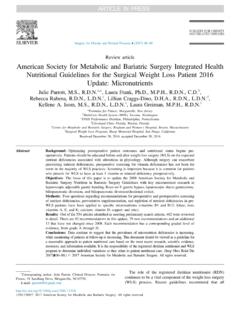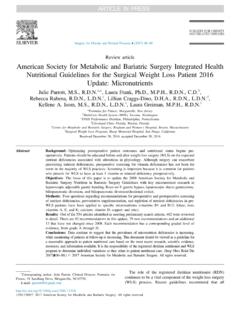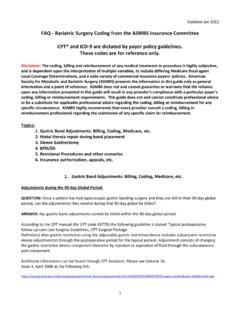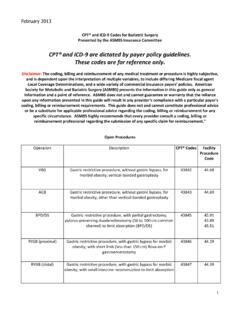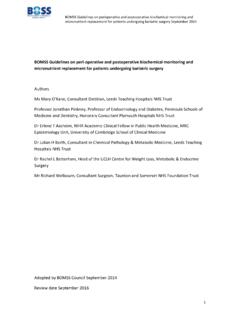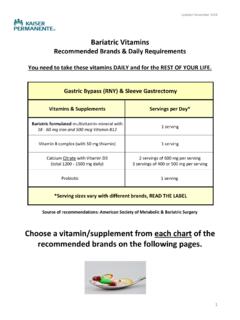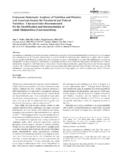Transcription of Clinical practice guidelines for the perioperative ...
1 GuidelinesClinical practice guidelines for the perioperative nutrition, metabolic ,and nonsurgical support of patients undergoing bariatric procedures 2019 update: cosponsored by american Association of ClinicalEndocrinologists/ american College of Endocrinology, The ObesitySociety, american society for metabolic & bariatric surgery , ObesityMedicine Association, and american society of AnesthesiologistsJeffrey I. Mechanick, , , , ,b,*, Caroline Apovian, ,Stacy Brethauer, , W. Timothy Garvey, , ,f,Aaron M. Joffe, , , Julie Kim, , Robert F.
2 Kushner, ,Richard Lindquist, , , Rachel Pessah-Pollack, , ,Jennifer Seger, , Richard D. Urman, , , , Stephanie Adams, ,John B. Cleek, , Riccardo Correa, , ,M. Kathleen Figaro, , , , Karen Flanders, , , ,Jayleen Grams, , ,s, Daniel L. Hurley, , ,Shanu Kothari, , , ,Michael V. Seger, , , ,Christopher D. Still, , , ,xaMarie-Jos ee and Henry R. Kravis Center for Clinical Cardiovascular Health at Mount Sinai Heart, New York, New YorkbMetabolic Support Divisions of Cardiology and Endocrinology, Diabetes, and Bone Disease, Icahn School of Medicine at Mount Sinai,New York, New YorkcNutrition and Weight Management, Boston University School of Medicine and Boston Medical Center, Boston, MassachusettsdOhio State University, Columbus, OhioeDepartment of Nutrition Sciences, Birmingham VA Medical Center, Birmingham, AlabamafUAB Diabetes Research Center.
3 University of Alabama at Birmingham, Birmingham, AlabamagUniversity of Washington, Harborview Medical Center, Seattle, WashingtonhHarvard Medical School, Mount Auburn Hospital, Cambridge, MassachusettsiNorthwestern University Feinberg School of Medicine, Chicago, IllinoisjProvidence Health Services, Seattle, WashingtonkDivision of Endocrinology, Diabetes and Metabolism, NYU Langone Health, New York, New YorklDepartment of Family and Community Medicine, Long School of Medicine, UT Health Science Center, San Antonio, TexasmBrigham and Women s Hospital, Boston, MassachusettsnAmerican Association of Clinical Endocrinologists, Jacksonville, FloridaoUniversity of Arizona College of Medicine, Phoenix, ArizonaThese guidelines are endorsed by The american society for Nutrition(ASN), the Obesity Action Coalition (OAC), International Federation forthe surgery of Obesity and metabolic Disorders (IFSO), International Soci-ety for the perioperative Care of the Obese Patient (ISPCOP)
4 , and the Amer-ican society for Parenteral and Enteral Nutrition (ASPEN).*Correspondence: Jeffrey I. Mechanick, , , , , Divisions of Cardiology and Endocrinology, Diabetes, andBone Disease, Icahn School of Medicine at Mount Sinai, Box 1030, NewYork, NY Mechanick). 2019 Published by Elsevier Inc. on behalf of american society for bariatric for Obesity and Related Diseases 16 (2020) 175 247 Downloaded for Anonymous User (n/a) at Harvard University from by Elsevier on March 06, personal use only. No other uses without permission.
5 Copyright 2020. Elsevier Inc. All rights Endocrine Group, Davenport, IowaqMassachusetts General Hospital Weight Center, Boston, MassachusettsrDepartment of surgery , University of Alabama at Birmingham, Birmingham, AlabamasBirmingham VA Medical Center, Birmingham, AlabamatDivision of Endocrinology, Diabetes, Metabolism, and Nutrition, Mayo Clinic, Rochester, MinnesotauGundersen Health System, La Crosse, WisconsinvBariatric Medical Institute of Texas, San Antonio, Texas, University of Texas Health Science Center, Houston, TexaswCenter for Nutrition and Weight Management Director, Geisinger Obesity Institute, Danville, PennsylvaniaxEmployee Wellness, Geisinger Health System, Danville, PennsylvaniaAbstractObjective.
6 The development of these updated Clinical practice guidelines (CPG) was commissionedby the american Association of Clinical Endocrinologists, The Obesity society , the american Soci-ety of metabolic and bariatric surgery , the Obesity Medicine Association, and the american Societyof Anesthesiologists boards of directors in adherence to the american Association of Clinical Endo-crinologists 2017 protocol for standardized production of CPG, algorithms, and :Each recommendation was evaluated and updated based on new evidence from 2013 to thepresent and subjective factors provided by.
7 New or updated topics in this CPG include contextualization in an adiposity-based, chronicdisease complications centric model, nuance-based, and algorithm/checklist-assisted clinicaldecision-making about procedure selection, novel bariatric procedures, enhanced recovery after bariat-ric surgery protocols, and logistical concerns (including cost factors) in the current healthcare are 85 numbered recommendations that have updated supporting evidence, of which 61 arerevised and 12 are new. Noting that there can be multiple recommendation statements within a singlenumbered recommendation, there are 31 (13%) Grade A, 42 (17%) Grade B, 72 (29%) Grade C, and101 (41%) Grade D recommendations.
8 There are 858 citations, of which 81 ( ) are evidence level(EL) 1 (highest), 562 ( ) are EL 2, 72 ( ) are EL 3, and 143 ( ) are EL 4 (lowest).Conclusions: bariatric procedures remain a safe and effective intervention for higher-risk patientswith obesity. Clinical decision making should be evidence-based within the context of a chronic dis-ease. A team approach to perioperative care is mandatory with special attention to nutritional andmetabolic issues. (Surg Obes Relat Dis 2020;16:175 247.) 2019 Published by Elsevier Inc. onbehalf of american society for bariatric words: bariatric surgery ; Obesity; guidelines ; metabolic surgery ; NutritionLay AbstractObesity is an officially recognized global disease andcontinues to be a risk factor for chronic medical conditionssuch as cardiovascular diseases, diabetes, chronic kidneydisease, nonalcoholic fatty liver disease, metabolic syn-drome, and many cancers.
9 This updated guideline is basedon an increased number and quality of the best availablescientific studies to guide physicians in the Clinical care ofpatients with obesity who undergo surgical and nonsurgicalbariatric procedures. This guideline identifies patient candi-dates for bariatric procedures, discusses which types ofbariatric procedures should be offered, outlines manage-ment of patients before procedures, and recommends howto optimize patient care during and after procedures. Sincepublication of the previous guideline in 2013, the role ofbariatric surgery in the treatment of patients with type 2diabetes has grown substantially.
10 Studies have demonstratedthat bariatric / metabolic surgery achieves superior improve-ments in glycemic control of patients with type 2 diabetesand obesity, compared with various medical and lifestyleinterventions, and leads to substantial cost cardiovascular outcomes and quality of life havealso been reported in patients undergoing bariatric and emerging surgical and nonsurgical bariatric pro-cedures are described. Criteria for bariatric procedures arebetter defined. This update includes checklists to assisthealthcare professionals achieve greater precision in clinicaldecision-making and discusses the importance of a teamapproach to patient care with special attention on nutrition,metabolism, and interventions to improve recovery afterbariatric surgery .
